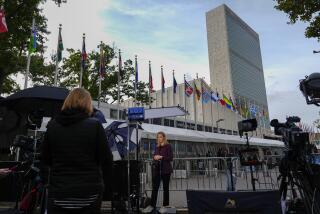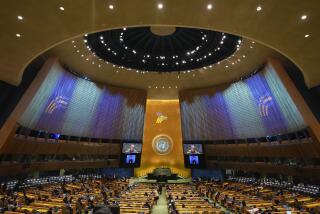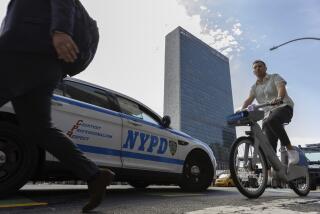What’s a Millennium Without New Fears and Reassurances?
Just a couple of years till the millennium, and all’s well.
The Dow has risen to dizzying heights. The Russians are our friends. Harrison Ford still looks as good as he did in “Star Wars,” for goodness’ sake.
So what have we got to worry about?
Well . . . asteroids. A giant chunk of rock could come screaming out of the sky and wipe out a major city--even civilization itself--in no time flat.
Or maybe there’s a deadly disease, capable of wiping out the human race, lurking in a tropical rain forest right at this moment.
Then again, there could be some terrorist group planning a gruesome biological weapons attack, or an unstable nuclear submarine commander keen on vaporizing the globe’s major capitals.
And what about global warming, ozone depletion, nuclear Armageddon? What if aliens come and eat us?
Kind of makes you nervous. After all, we had our share of close shaves this millennium, what with wars, cataclysms, epidemics and interleague play threatening our existence at every turn. Can we really expect to make it through the next thousand years?
The turn of a millennium just naturally raises that question. The last one probably found the Constantinople constabulary dealing with guys standing on street corners, ranting about judgment and holding signs proclaiming “The End is Near.”
As the year two oh-oh-oh approaches, visitors to New York’s Times Square, London’s Speakers’ Corner and pretty much anywhere remotely in the vicinity of San Francisco will undoubtedly hear the same type of thing.
Could the doomsayers be right? Well, let’s go to our panel of experts.
“This is not something that causes me to lie awake at night,” said John Lewis, a University of Arizona astronomer who specializes in comet and asteroid collisions.
Using the craters on Earth and the moon as a gauge, Lewis and his colleagues have determined that every millennium or so an object packing 50 to 100 megatons of explosive power hits Earth.
That’s enough to wipe out a major city--which would be a shame. But it’s not nearly enough to bring civilization to its knees.
It would take an object miles across, packing 100 million megatons or more, to imperil the entire globe. And things that big only hit Earth every 10 million years at the most, putting their chances of hitting during any 1,000-year period at less than one in 10,000.
And if those odds aren’t enough to reassure you, Lewis said, astronomers would know a thousand years ahead of time that such an object was on a collision course with Earth. The world would have plenty of time to find a way to nudge it off course, with carefully placed nuclear missiles or some similar means.
“The chances of civilization coming to an end in the next thousand years due to an impact are probably slim,” Lewis said.
OK, but what about ozone depletion? Aren’t chlorofluorocarbons eating a hole in the invisible blanket that protects us from the sun’s harmful ultraviolet rays?
Yes they are. But thanks to international agreements that will phase out ozone-destroying chemicals early in the next century, things look pretty good on that front. Chlorofluorocarbon concentration in the atmosphere has already begun dropping thanks to the international phaseout, and scientists expect the ozone to be back to normal by about 2050.
The news isn’t so good down the hall in the global warming department, however. The latest estimate by the United Nations International Panel on Climate Change puts the globe’s average temperature in 2100 just over 3 degrees Fahrenheit higher than it is today. That amount of warming would probably move major agricultural regions, cause more frequent and powerful hurricanes and melt the polar ice sheets enough to raise sea level 20 inches.
Strictly speaking, it won’t be the end of the world. But if you live in a low-lying country like Belgium, Belize or Bangladesh, watch out.
“Sea level rise could drown a lot of our coastal lands and redraw the map of our nation,” said Stephen Leatherman, head of the Laboratory for Coastal Research at the University of Maryland.
The big trouble in the next century would be along the Atlantic Ocean and Gulf of Mexico, where flat coastal plains and low-lying wetlands stretch for miles.
And the next century is nothing compared to the next 1,000 years. Glaciologists have found that the western part of the Antarctic ice sheet is remarkably unstable, and eventually the whole thing could just melt. It’s bound to happen sooner or later, and when it does it will raise sea level by a good 30 feet.
“There would be just no way to deal,” Leatherman said.
Bye bye, Boston. Adios, Miami. New Orleans, adieu.
But we’ll always have Denver.
Speaking of which, this year’s meeting of the G-7 nations in the Mile High City brings up another millennial threat. With the world’s economy booming, and people and goods flying all over the planet, there’s always the possibility that somebody could catch a deadly disease in Borneo and spread it around Boston before they even felt sick.
In 1994, 10% of the people who died between the ages of 1 and 49 did so suddenly and mysteriously--and presumably from some unidentified infection, Minnesota epidemiologist Michael T. Osterholm told a congressional committee recently.
“How can we as a nation invest only $42 million a year of federal resources into all infectious disease surveillance?” Osterholm asked the committee. “The U.S. military spends $225 million maintaining musical bands.”
As those bands play on, infectious diseases pop up around the globe. In this decade there has been plague in India, cholera in South America and the deadly ebola virus in Africa. Meanwhile, old standbys that public health officials thought they had beat--TB, pneumococcus, enterococcus--are growing resistant to antibiotics.
“Today we know very little about the very rapidly emerging problem of antibiotic resistant bacteria and viruses,” Osterholm said.
We do know this: In 1918, before antibiotics were developed, a global flu epidemic killed 20 million people.
Of course, it doesn’t take a killer microbe to wipe out civilization. Humans could do it themselves. The end of the Cold War notwithstanding, Russia and the United States each have 8,000 to 10,000 nuclear warheads at hand, which is enough to totally destroy one another 10 or 20 times. China has about 500, Britain and France have a few hundred each, and Israel, Pakistan and India are thought to have a few stashed away as well.
“The big question down the road is China,” said David Wright, an arms control analyst at the Union of Concerned Scientists in Cambridge, Mass. As China’s military and economic power grows over the next 10 to 20 years, it may decide to build more nuclear weapons, he said. U.S. policymakers should keep that in mind.
Some people also worry that terrorists will get their hands on enough plutonium or uranium to build a nuke. But Wright said that probably won’t happen because it takes quite a bit of technology to build a bomb.
Chemical and biological weapons, on the other hand, are a piece of cake. The Aum Shinrikyo cult killed 12 people when it released nerve gas on the Tokyo subway two years ago, and many more could have died if the terrorists hadn’t been so inept.
But even competent terrorists probably couldn’t end the world with biological weapons. An attack of anthrax bacteria that exposed 100,000 people would kill nearly a third of them, a paper in a recent issue of Emerging Infectious Diseases estimated. Again -- a catastrophe, but not the kind that’s going to wipe out an entire civilization.
To most people who think about these things, the real threat--the big challenge for humanity in the next millennium--isn’t dread diseases, crazed terrorists or asteroid bombardment. Paradoxically, the big threat to well-being in the next millennium isn’t the decimation of the world’s population, but its growth.
In the next century, the number of people on the planet is expected to climb past six billion on its way to eight, 10 or maybe even 12 billion. It’s simply going to be harder and harder to keep all those people fed, clothed, and housed, said Joel Cohen, the author of “How Many People Can the Earth Support?”





